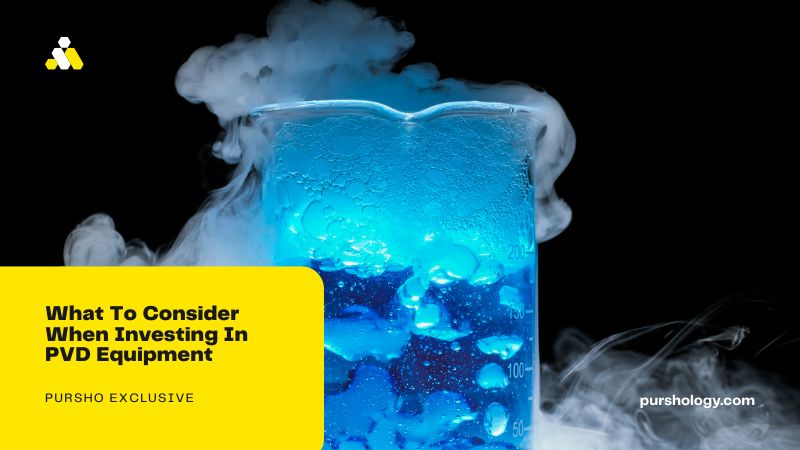Precision and inventiveness are now essential components of modern production processes. Physical Vapour Deposition (PVD) is one of the technologies that has gained popularity in recent years. PVD is a coating method that improves the qualities of different materials, making them more durable, corrosion-resistant, and aesthetically pleasing. As more companies use PVD technology, purchasing PVD equipment has become critical. This blog will look at things you should consider before investing in PVD equipment to ensure that it corresponds with your business goals and provides a solid return on investment (ROI).
Purpose And Application
The first step in selecting the appropriate PVD equipment is defining your goal and application. Understand your industry’s specialised requirements, whether boosting tool performance, developing attractive coatings, or increasing wear resistance. Sputtering, evaporation, and ion plating are all PVD processes with distinct advantages and disadvantages. Determine which technique is most suited to your application.
Budget
Purchasing PVD equipment is a significant financial investment. Create a budget that accounts for the original equipment cost, installation charges, and ongoing operational costs. Make sure your budget includes not only the purchase but also maintenance, consumables, and employee training. A well-defined budget can assist you in making informed judgments throughout the purchase process.
Quality And Reliability
The quality and dependability of PVD equipment are critical. Look for companies that have a reputation for creating high-quality machinery. Look for certifications and conformity with industry standards as signs of equipment reliability. Reliable equipment has a longer lifespan and requires fewer repairs, decreasing downtime and increasing ROI.
Coating Thickness And Uniformity
PVD equipment’s coating homogeneity and thickness are crucial for producing reliable results. Invest in technology that enables you to accurately control the thickness and consistency of your coatings, as this will directly influence your product’s performance and appearance. Inadequate thickness control can lead to layers that need to satisfy industry standards.
Substrate Compatibility
Consider whether your substrates are compatible with the PVD equipment. Different materials may necessitate other pretreatment procedures or changes to the deposition conditions. Make sure the equipment you purchase can handle a variety of substrates, allowing for flexibility in your manufacturing operations.
Production Capacity
Examine your manufacturing requirements thoroughly. PVD equipment is available in various sizes and configurations, from small batch systems to large-scale production lines. Select equipment that meets your production capacity requirements. Investing in a system that is too tiny can limit your progress while investing in one that is manageable can result in efficient resource utilisation.
Energy Efficiency
Businesses are increasingly concerned with sustainability and energy efficiency. Look for PVD equipment designed to consume less energy and generate less trash. Energy-efficient technologies lower operational expenses and contribute to your company’s environmental stewardship.
Maintenance and Support
Regular maintenance is essential for keeping PVD equipment functioning at peak efficiency. Inquire about the manufacturer’s service and support options. Timely servicing and readily available spare parts can reduce downtime and increase the life of the equipment. Consider the availability of technical assistance and employee training to ensure efficient functioning.
Regulatory Compliance
Depending on your industry and location, your PVD equipment may be subject to additional regulations and safety standards. To keep your employees safe and out of legal trouble, buy equipment that meets all applicable standards.
Return on Investment (ROI)
Calculate the PVD equipment’s expected return on investment. Think about ways to improve the quality of your items, cut down on waste, crank out more goods, and introduce brand-new offerings. A well-calculated return on investment study will help you convince stakeholders and sway their decisions.
Future Growth and Scalability
As your business develops, you may have different PVD equipment needs. Invest in equipment that is scalable and flexible to handle future expansion. It can include adding modules or modifying current systems without significantly disrupting your operations.
User-Friendly Interface and Software
User-friendliness is critical for efficient operation and shortening training time. Choose PVD equipment with an intuitive interface and user-friendly software. A well-designed interface can assist operators in more effectively setting up processes, monitoring performance, and troubleshooting issues.
What Are The Benefits Of Physical Vapour Deposition Coating?
PVD coating (Physical Vapour Deposition) has significant advantages over other coating processes, making it a preferred choice for various applications. Here are some of the primary benefits of PVD coating:
Excellent Adhesion
PVD coatings form strong connections with the substrate material and have good adherence. Ir keeps the covering firmly in place and prevents it from peeling or delaminating over time.
Precise Thickness Control
PVD methods provide for fine control of the deposited film thickness. This level of control is critical for applications that demand precise coating thicknesses for maximum performance.
Uniform Coating
PVD coatings ensure consistent and even coating thickness over complex forms and surfaces, which is frequently difficult to achieve with other technologies.
Enhanced Surface Properties
PVD coatings can improve substrate surface qualities like hardness, wear resistance, corrosion resistance, and lubricity. As a result, they are appropriate for applications where surface performance is crucial.
Wide Range of Materials
PVD can deposit various materials, including metals, ceramics, and polymers. This adaptability allows for selecting materials that best suit the application’s needs.
Reduced Environmental Impact
Compared to other coating technologies, PVD operations are generally considered more environmentally benign. They generate less hazardous byproducts and often employ fewer damaging chemicals.
Low Thermal Stress
PVD coating is a low-temperature method that causes little thermal stress on the substrate. It is especially critical for materials or components that are temperature-sensitive.
Enhanced Wear Resistance
Cutting tools, moulds, and automobile parts can all benefit from PVD coatings because of their exceptional durability against abrasion, friction, and wear.
Final Thoughts
Investing in Physical Vapour Deposition equipment is a calculated move that can have far-reaching consequences for the success and growth of your business. By considering factors including need, cost, quality, coating capabilities, substrate compatibility, production capacity, energy efficiency, maintenance, compliance, ROI, scalability, and user-friendliness, you can make a choice that is by your long-term aims.
Remember that PVD technology constantly evolves, so staying current on the latest improvements is critical to maximising your investment. PVD equipment can be a significant differentiator in the ever-changing industrial industry, and a well-informed investment can provide your company with a competitive edge.




